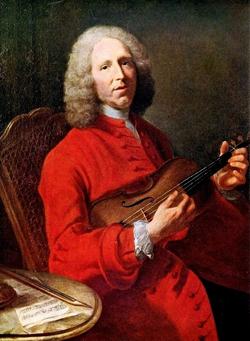Composer (MIDI)
Jean-Philippe Rameau (1683-1764); FRA
 Loading, please wait...
Loading, please wait...
Rameau, Jean-Philippe (b Dijon, 1683; d Paris, 1764). Fr. composer, harpsichordist, and organist. Self-taught in harmony and counterpoint. Visited It. 1701. Org., Clermont-Ferrand 1702-5, Paris 1705-8, Dijon 1709-14, Lyons 1714-15, and then Clermont-Ferrand again 1715-22, where he worked on his important Traité de l'harmonie, pubd. in Paris 1722, in which he set out the then novel doctrines of inversions of chords and principles of chord-progression. This was followed by other textbooks on harmony between 1726 and 1752, and by his dissertation on methods of acc. for hpd. and org. (1732). Settled in Paris 1722, teaching the hpd. and writing many works for the instr. In 1730 he came under the patronage of Le Riche de la Pouplinière. In 1733, at the age of 50, his first opera, Hippolyte et Aricie, met with no success, but he persevered and wrote over 20 operas and opera-ballets, incl. Castor et Pollux and Les Indes galantes. These works, though controversial because of their novel use of colourful orchestration, bold harmonies, and use of recit., est. Rameau as Lully's successor in the field of Fr. opera. His champions opposed those of Pergolesi in the Querelle des Bouffons. In 1745 he was appointed chamber mus. composer to the King. Prin. works:
OPERAS AND OPERA-BALLETS: († = opera-ballet): Hippolyte et Aricie (1733, rev. 1742); Les Indes galantes (1735-6); Castor et Pollux (1737, rev. 1754); †Les Fêtes d'Hébé (1739); Dardanus (1739, rev. 1744 and 1760); †Les Fêtes de Polymnie (1745); Le Temple de la gloire (1745, rev. 1746); †Platée (1745, rev. 1749); †La Princesse de Navarre (1745, rev. 1763); †Les Fêtes de l'Hymen et de l'Amour (1747); †Zaïs (1748); †Les Surprises de l'amour (1748, rev. 1757); †Pygmalion (1748); Nais (1749); Zoroastre (1749, rev. 1756); Acante et Céphise (1751); †La guirlande (1751); Daphne et Eglé (1753); Les Sybarites (1753); Lysis et Delia (1754); La Naissance d'Osiris (1754); Zéphire (1757); Nélée et Mithis (1757); Le Retour d'Astrée (1757); †Anacréon (1757); Les Paladins (1760); Les Boréades (Abaris) (1763).
CANTATAS & SACRED WORKS: Thétis (1718); Aquilon et Orinthié (1719); Les Amants trahis (1721); Orphée (1721); L'Impatience (1715-22); Le Berger fidèle (1728); Pour la fête de St-Louis (1740); Deus Noster Refugium (before 1716); In Convertendo (1718); Quam dilecta (c.1720).
CHAMBER MUSIC: 5 Pièces de clavecin en concert for hpd., va. da gamba, baroque vn. (1741); 5 Concerts for hpd., vn., fl. (1741).
HARPSICHORD: (pubd. in 3 vols. of suites in Rameau's lifetime): 1. Prelude, 2. Allemande 1, 3. Allemande 2, 4. Courante, 5. Gigue, 6. Sarabande 1, 7. Sarabande 2, 8. La Vénétienne, 9. Gavotte, 10. Menuet, 11. Menuet en rondeau, 12. Allemande, 13. Courante, 14. Gigue en rondeau, 15. 2nd Gigue en rondeau, 16. Le Rappel des oiseaux, 17. Rigaudon 1, 18. Rigaudon 2, 19. Double, 20. Musette en rondeau, 21. Tambourin, 22. La Villageoise (rondeau), 23. Les Tendres Plaintes (rondeau), 24. Les Niais de Sologne, 25. Doubles 1 des Niais, 26. Doubles 2 des Niais, 27. Les Soupirs, 28. La Joyeuse, 29. L'Ollette (rondeau), 30. L'Entretien des Muses, 31. Les Tourbillons (rondeau), 32. Les Cyclopes (rondeau), 33. Le Lardon (menuet), 34. La Boiteuse, 35. Allemande, 36. Courante, 37. Sarabande, 38. Les Trois Mains, 39. Fanfarinette, 40. La Triomphante, 41. Gavotte (with 6 doubles), 42. Les Tricotets (rondeau), 43. L'Indifférente, 44. Menuet 1, 45. Menuet 2, 46. La Poule, 47. Les Triolets, 48. Les Sauvages, 49. L'Enharmonique, 50. L'Egyptienne, 51. La Dauphine, 52. La Laivri (rondeau), 53. L'Agaçante, 54. La Timide (rondeau), 55. La Timide (rondeau), 56. L'Indiscrète (rondeau).
Copyright © 1996 Oxford University Press - By permission of Oxford University Press
###
Read biography at allmusic.com.

|
Rameau, Jean-Philippe (b Dijon, 1683; d Paris, 1764). Fr. composer, harpsichordist, and organist. Self-taught in harmony and counterpoint. Visited It.... More
|
-
Stage Works
5 midis
- Dardanus (tragédie en musique)
1 midi
- Hippolyte et Aricie (tragédie lyrique)
1 midi
- Les Boréades (tragédie en musique)
1 midi
- Pygmalion (acte de ballet)
2 midis
- Dardanus (tragédie en musique)
-
Keyboard Works
29 midis
- Nouvelles suites de pièces de clavecin
19 midis
- Pièces de clavecin
10 midis
- Nouvelles suites de pièces de clavecin
-
Vocal Works
1 midi
- Laboravi Clamans
1 midi
- Laboravi Clamans
-
Stage Works
5 midis
- Dardanus (tragédie en musique)
1 midi
- Hippolyte et Aricie (tragédie lyrique)
1 midi
- Les Boréades (tragédie en musique)
1 midi
- Pygmalion (acte de ballet)
2 midis
- Dardanus (tragédie en musique)
-
Keyboard Works
29 midis
- Nouvelles suites de pièces de clavecin
19 midis
- Pièces de clavecin
10 midis
- Nouvelles suites de pièces de clavecin
-
Vocal Works
1 midi
- Laboravi Clamans
1 midi
- Laboravi Clamans









 Files of this type are not available at this time. Please select ALL from above.
Files of this type are not available at this time. Please select ALL from above.
 Click on a category to view the list of works
Click on a category to view the list of works


